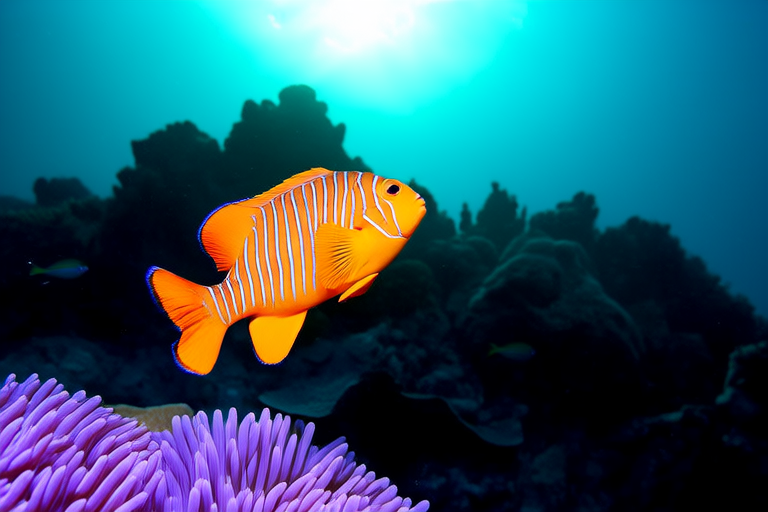Top 10 Fascinating Facts About Clownfish That Will Amaze You
Clownfish, those iconic orange and white striped fish from Finding Nemo, have captured the hearts of many. But beyond their vibrant appearance and endearing personalities, these creatures harbor numerous intriguing secrets that will leave you amazed. From their symbiotic relationship with sea anemones to their unique reproductive behaviors, here are ten fascinating facts about clownfish that will expand your understanding of these marine marvels.
Fact 1: A Symbiotic Partnership with Sea Anemones
The relationship between clownfish and sea anemones is one of nature’s most remarkable partnerships. While other fish would be stung by the anemone’s venomous tentacles, clownfish are immune due to a special mucus layer on their skin. This protective coating allows them to live among the anemone’s tentacles, offering protection from predators while the clownfish helps attract food for the anemone by driving away polyp-eating fish.
Fact 2: They’re Masters of Camouflage
Clownfish are experts at blending into their environment. Their vibrant colors may seem like a beacon to predators, but their stripes actually serve as a form of camouflage. The black and white stripes break up the outline of the fish, making it harder for larger fish to spot them against the backdrop of coral reefs. Additionally, their coloration can mimic the appearance of the sea anemone’s tentacles, further confusing potential threats.
Fact 3: Clownfish Can Change Gender
One of the most surprising aspects of clownfish biology is their ability to change gender. In a typical clownfish group, there is one dominant female and a male partner. If the female dies, the male can transform into a female within a few weeks. This transformation involves changes in hormone levels and physical features, ensuring the continuation of the species.
Fact 4: They Have a Unique Locomotion Style
Unlike many fish, clownfish swim with a distinctive side-to-side motion. This swimming style not only makes them more agile and efficient swimmers but also allows them to navigate through the intricate coral reef environments where they live. Their pectoral fins help them maintain balance and maneuver around obstacles, while their caudal fin provides thrust.
Fact 5: Clownfish Are Vocal Creatures
Contrary to popular belief, clownfish are not silent underwater. They produce a variety of sounds, including grunting, popping, and clicking noises. These vocalizations play crucial roles in communication, such as establishing territory, attracting mates, and warning off intruders. Researchers have found that clownfish can even recognize the sound of familiar individuals, further emphasizing the importance of vocalization in their social interactions.
Fact 6: They Live in a Hostile Environment
Coral reefs, home to clownfish, are some of the most diverse ecosystems on Earth. However, they are also extremely hostile environments. Clownfish must constantly adapt to changing water temperatures, salinity levels, and pH levels. They have evolved thick skin and specialized cells that allow them to thrive in these conditions, making them resilient to environmental fluctuations.
Fact 7: Clownfish Are Not Always Orange
While the classic orange and white clownfish are well-known, not all clownfish species share this striking coloration. Depending on the species and the specific environment, clownfish can exhibit a wide range of colors, including yellow, red, and maroon. Even within the same species, variations in diet and genetics can lead to different shades of coloration, adding to the diversity of these fascinating creatures.
Fact 8: They Exhibit Complex Social Structures
Clownfish groups typically consist of a single breeding pair and several non-breeding males. These social hierarchies are maintained through aggressive displays and dominance rituals. The dominant female ensures her position by regularly chasing away subordinate males and females. This complex social structure helps to minimize conflict and optimize resource allocation within the group.
Fact 9: Clownfish Eggs Are Cared For Diligently
After mating, the female lays her eggs in a carefully selected location near the sea anemone. The male then takes on the role of caregiver, diligently protecting the eggs from predators and ensuring they are aerated by fanning his fins over them. This attentive care increases the chances of successful hatching, contributing to the survival rate of clownfish populations.
Fact 10: Clownfish Are Vulnerable to Environmental Changes
Despite their resilience, clownfish face significant threats from environmental changes, particularly climate change and ocean acidification. Rising sea temperatures can stress coral reefs, leading to bleaching events that harm both the anemones and the clownfish that depend on them. Additionally, increased acidity in the ocean can impair the ability of clownfish larvae to detect chemical cues used to locate suitable habitats. Conservation efforts are crucial to protect these delicate ecosystems and ensure the survival of clownfish populations.
In conclusion, clownfish are not just colorful inhabitants of coral reefs; they are complex creatures with unique behaviors and adaptations that have allowed them to thrive in challenging environments. By exploring these fascinating facts, we gain a deeper appreciation for the intricate web of life in our oceans and the importance of preserving marine biodiversity.
